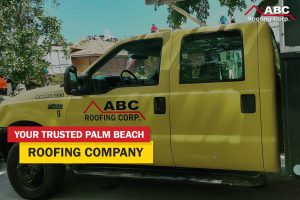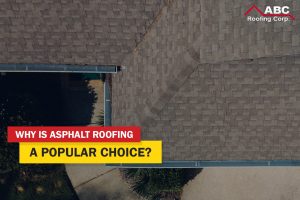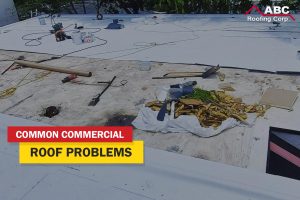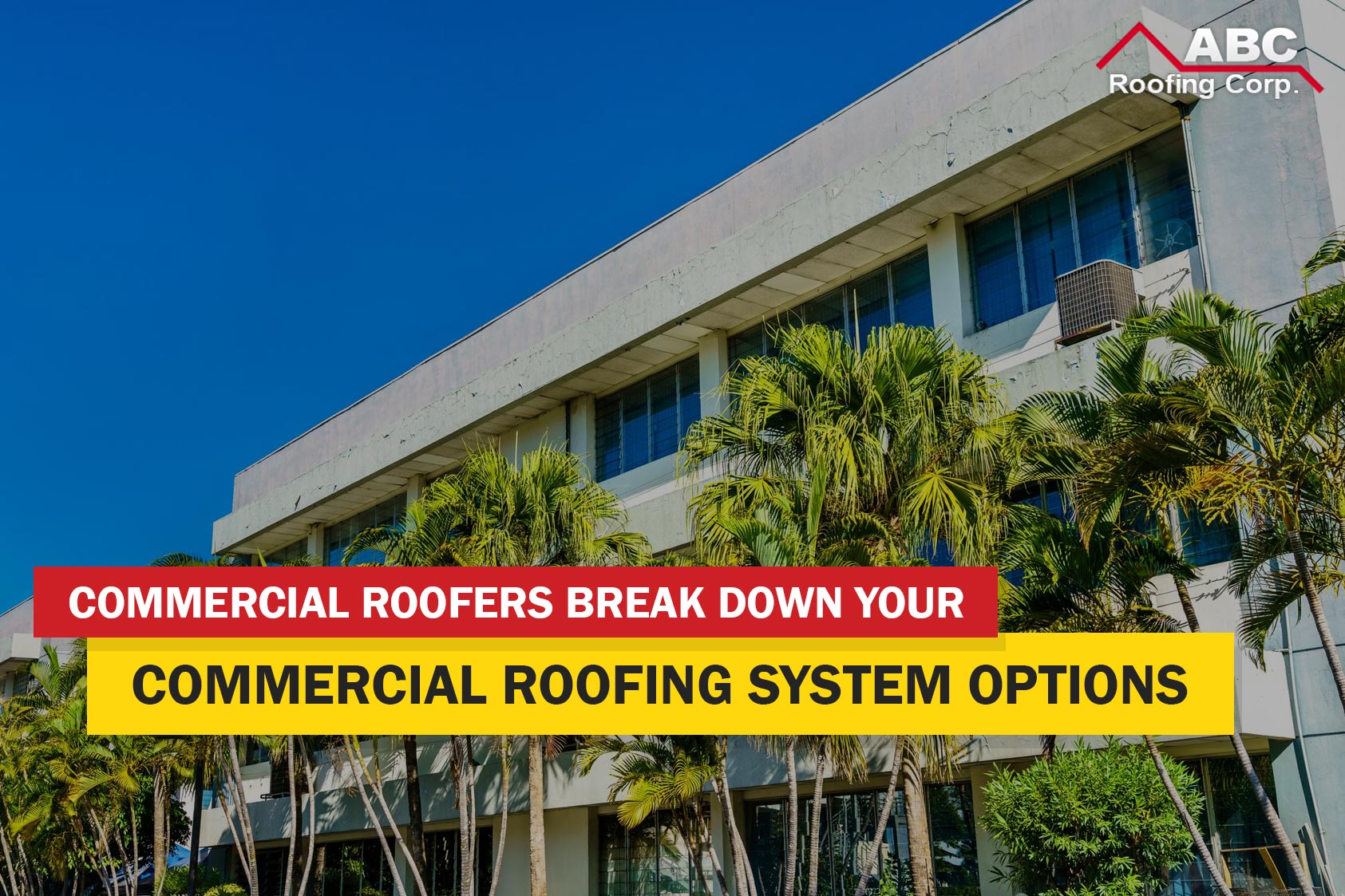
For any commercial property, the roofing system you choose is a significant investment in the company and its people. By protecting the business’s valuable assets, employees, and operational continuity from the elements, the importance of a reliable roof can’t be overstated.
Of course, there are so many options available that it can be overwhelming to consider which option works best for your needs. This is the perfect time for experienced commercial roofers to provide a comprehensive guide on commercial roofing options.
So, keep reading as we discuss the most common commercial roofing systems and break down the pros and cons for you!

Why Are Commercial Roofs So Important?
For any business operation, especially in South Florida, making the best decision on your commercial roof is essential. Beyond making the right decision on the type of roofing system, it’s also crucial to partner with excellent commercial roofers with the skills and expertise required to do the job right.
Here are some of the fundamental advantages that a commercial roof will provide for your business:
- Protection from the elements for your business assets, ensuring that sun, wind, and rain do not destroy them
- Operational energy efficiency to maximize the efficiency of HVAC systems and minimize energy wastage
- Structural integrity and longevity to ensure that the supporting structural parts of your roof do not get water-damaged or decay over time
- Ensuring business continuity by eliminating the risks of lengthy repair downtime and loss of productivity
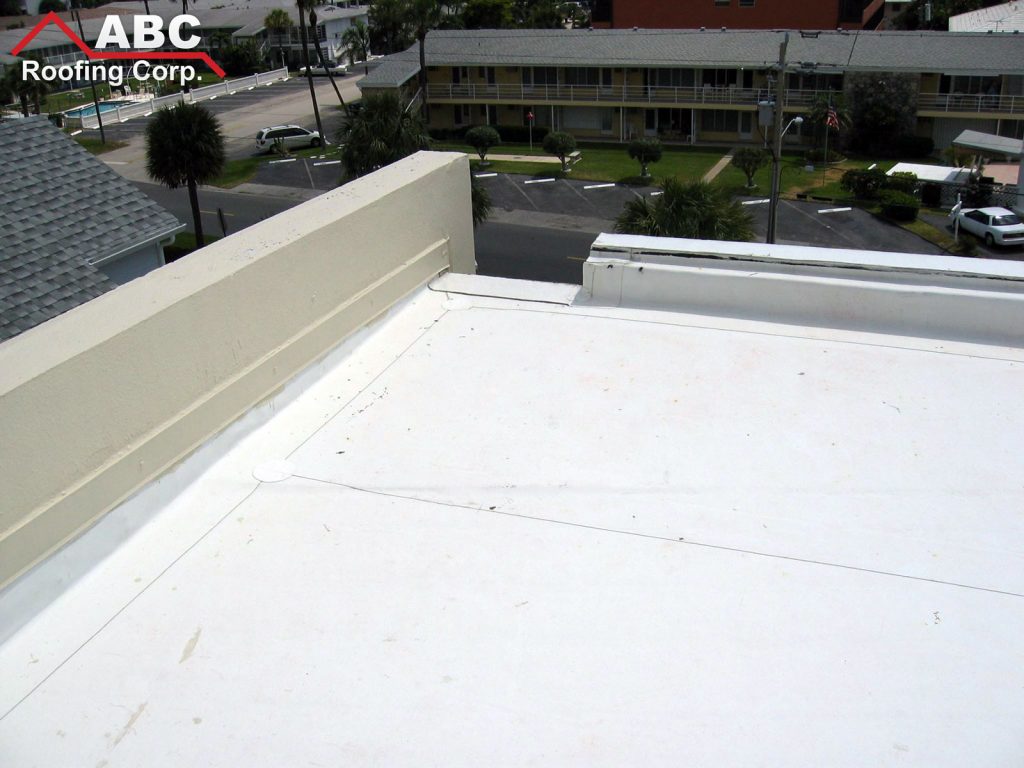
Membrane Roofing
Whether your commercial property has a flat or low-sloped roof, membrane roofing systems are a popular choice. These systems are seamed together, or overlapped to create a watertight barrier made up of flexible sheets of modified material designed to weather the elements.
Single-Ply Membranes
As the name suggests, single-ply membranes refer to roofing systems where you lay them down and it’s “one and done”. There is no need to use multiple layers of these membranes as they are designed to be flexible, watertight, and durable, resisting the worst of the sun’s UV rays.
Three types of single-ply membranes are very popular in today’s commercial roofing systems:
Thermoplastic Polyolefin (TPO)
One of the newer kids on the block is TPO, and has become a significantly popular option for roofers and business owners combined. TPO owes a lot of its popularity to the levels of performance that it provides in the area of energy efficiency and its excellent UV radiation resistance. It is also very resistant to chemicals and punctures, making it a very hard-wearing material. And on top of it all, the membrane is white so it can reflect most of the sun’s heat, keeping the building underneath as cool as possible, alleviating the load on the HVAC system.
Pros of TPO:
- A reflective, energy-efficient surface that significantly lowers cooling bills
- Durable membrane resistant to UV rays, ozone, and chemical exposure
- Flexible to accommodate building movement
- Lightweight option that reduces stress on the building structure
- Environmentally friendly, recyclable option
Cons of TPO:
- Longevity is unknown, as it is a newer material for which long-term data is still being collected.
- Proper installation of seams is crucial for preventing leaks
- Some lower-grade TPO membranes may be more susceptible to punctures
Polyvinyl Chloride (PVC)
PVC is also popular for its chemical resistance, and so it is often a popular consideration for areas that deal with a lot of oil and grease exposure. Additionally, PVC is a durable, fire-resistant material, and so is also a boon for commercial roofs where fire risk is higher.
Pros of PVC:
- Excellent chemical resistance is ideal for restaurants, factories, and other businesses with chemical exposure
- Offers a high level of fire resistance
- Durable, long-lasting, and resistant to weathering
- Hot-welded seams create a very strong and watertight seal
Cons of PVC:
- Contains chlorine, which raises some environmental concerns during manufacturing and disposal
- It may be relatively more expensive than other single-ply options
Ethylene Propylene Diene Monomer (EPDM)
If you are looking for a highly flexible and highly durable single-ply membrane then EPDM is what you need. EPDM offers excellent weather resistance and is accompanied by a long lifespan. Commercial roofers often refer to EPDM as “rubber roofing,” and it is available in both black and white options.
Pros of EPDM:
- Has excellent weather resistance and can withstand extreme temperatures, UV radiation, and the ozone layer
- Highly flexible, accommodating building movement and temperature fluctuations
- Long lifespan, with proper maintenance, can last over 20-30 years
- Often a more budget-friendly option compared to other single-ply membranes
- Easy to repair, generally a straightforward exercise
Cons of EPDM:
- Can be more easily punctured than TPO or PVC
- In hot climates such as South Florida, black EPDM can increase cooling costs
- If not installed properly, the adhesive from the bonded seams can be a potential point of failure
Modified Bitumen
When referring to modified, the industry is describing that additional materials, or modifiers, are being added to the bitumen to improve its strength and durability. It also provides a substrate for the bitumen to soak into. The asphalt base is complemented by multiple layers of fiberglass or polyester fabrics. These modifiers add to the durability and the waterproofing effectiveness of the materials.
Pros of Modified Bitumen:
- Multi-layered system provides durable and long-lasting protection
- Effective at withstanding a variety of weather conditions
- Can be a cost-effective option compared to some other systems
Cons of Modified Bitumen:
- Installation can be dangerous, as torch-applied systems pose a fire risk
- Hot asphalt application can produce strong, unpleasant odors
- Regular maintenance is required, as well as regular inspections, to ensure longevity
Built-Up Roofing (BUR)
As one of the oldest commercial roofing systems still in use, built-up roofing can also be one of the costliest but one of the most effective. The installation involves layers of asphalt or coal tar being spread on the roof surface and reinforced with felts or fabrics that are applied alternately in layers. Once all of the layers have been laid down, the top is coated in a reflective coating or a layer of gravel. These roofs are best in areas where the roof will see routine foot traffic.
Pros of BUR:
- Extremely durable system that offers excellent protection and will last a very long time
- The multiple-layered approach creates a robust barrier against water intrusion
Cons of BUR:
- Heavy solution that adds significant weight to the building structure
- Like modified bitumen, the installation can be messy and involve strong odors
- Locating leaks can be challenging, and repairing them even more so
- Typically dark in color and absorbs heat easily, so it will negatively impact your HVAC efficiency
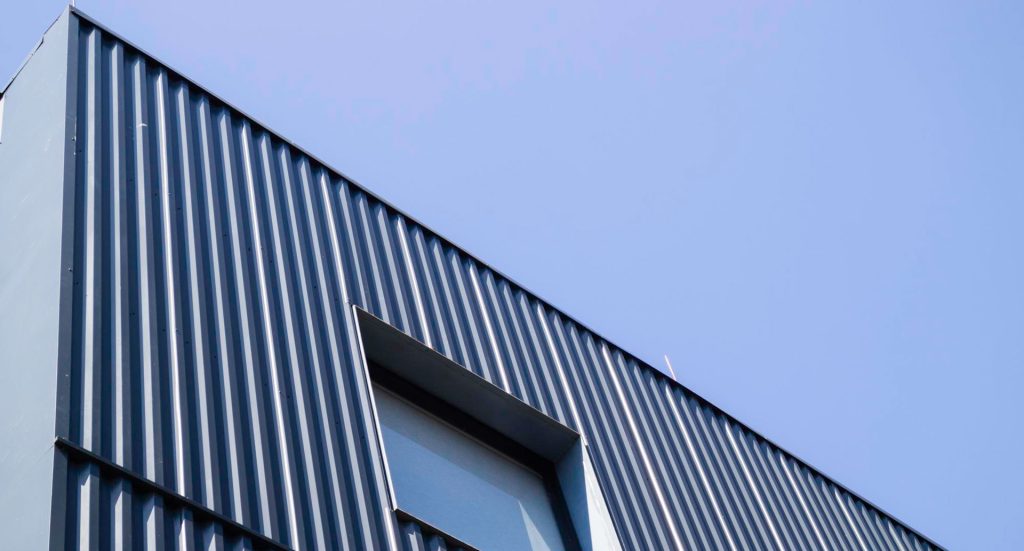
Metal Roofing
Metal roofing is popular in two main configurations, standing seam and corrugated panels. Corrugated panels are typically screwed into the rafters below while standing seam panels make use of special connectors and a seam that is folded on the standing edge of each panel.
There are a few different types of metal that can be used, and these include:
- Steel
- Aluminum
- Copper
- Zinc
Pros of Metal Roofing:
- Extreme longevity can last for 50 years or more with proper maintenance
- Reflective coatings can significantly reduce cooling costs in areas such as South Florida
- Requires minimal upkeep compared to other systems.
- Non-combustible material offers excellent fire protection.
- Often made with recycled content that is also recyclable at the end of its lifespan.
- Enhances curb appeal with its neat finish and tidy appearance
Cons of Metal Roofing:
- Generally, more expensive to install than some other roofing systems
- Can be noisy during heavy rainfall or hailstorms
- Thermal movement can cause issues if not properly installed
- Some thinner-gauge metals can be susceptible to denting from hail or falling debris
- Proper installation requires special expertise and is crucial to prevent leaks and ensure longevity
Factors to Consider Before Deciding On A Roofing System
Other than choosing a great commercial roofing system for a property, it’s wise to make a decision that is based on the pertinent parameters surrounding the client, property, area, and many other factors. Let’s break down some of the most important considerations:
Budget
The initial cost of a commercial roofing project is only one dimension. There are also the cost considerations of what the cost of maintenance will be over the lifespan of the roof. In terms of running expenses, companies might also want to consider the impact that the roofing system will have on ongoing energy costs for the business.
Climate
In areas such as South Florida, a lot of your choices are made easier in that you need a roof that can withstand hurricane-force wind speeds. But other considerations, such as hours and strength of sunshine, as well as rain and ambient humidity, will have an impact too.
Building Structure
The type of roof slope and the load-bearing capacity of the roof frame, as well as that of the building, will also inform some of your decisions. When unsure about structural issues, it’s important to remember that you may have to pay an engineer to consult on the work.
Energy Efficiency Goals
Some clients may require that their energy efficiency goals be paramount. If this is the case, then it’s best to consider a more reflective, cooler roofing solution.
Building Use
What operational activities are going to be undertaken within the building? Will there be an excessive use of chemicals or other harmful substances? Perhaps the roof will require a lot of human access and foot traffic. These are important questions to ask when assessing the right roofing system.
Aesthetics
The appearance of your roof can impact the overall look of your commercial property.
The appearance of a property can positively or negatively affect its perceived value. Some clients may want to have their property make a statement, in which case an aesthetically pleasing system may be the answer.
Understand Applied Warranties
Depending on the roofing system and brand that is chosen, the manufacturers may provide different warranties and warranty periods. Added to this, the installation company may also have some specific provisions about the warranty of their installation, so make sure that you understand these at the outset.
Local Building Codes
As with any roofing project in South Florida, roofing codes are among the strictest in the country and have to be adhered to, or you will not get planning approved.
Maintenance Requirements
Depending on what system you choose, always keep in mind that certain roofs are going to require different maintenance schedules. It’s important to decide on a roofing system that you will be able to maintain going forward.
Partnering with Experienced Commercial Roofers
Choosing to work with a certified and professional commercial roofer is essential to the success of any new roof or roofing upgrade/repair project. They can lend their skills and expertise to each situation and also provide you with additional peace of mind because of their experience in the industry. Additionally, they’ll also be on hand to handle any maintenance requirements and maintain your roof’s compliance status with local and state building codes.

ABC Roofing Corp: Commercial Roofers You Can Rely On
In South Florida, ABC Roofing Corp has been at the forefront of commercial roofing for over 30 years. Whether you’re looking at a Built-up roofing project or want to delve into one of the more modern single-ply membranes, our team has the experience and skills to consult, install, or repair your commercial roof. Call us at 954-344-4622 to find out more.

